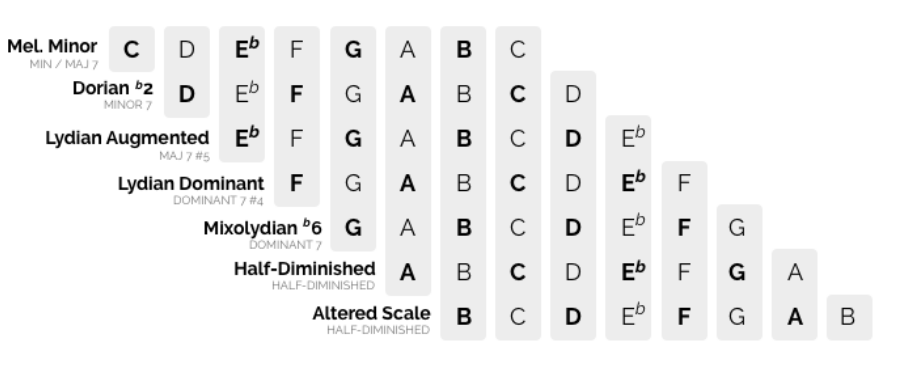Throughout this website, we talk quite a lot about the modes of the major scale. When we consider the tonal center of a tune, we almost always reference one of those major modes.
But, the modes of the melodic minor scale are useful too. They provide colorful scales that are useful over specific chord voicings and alterations, which don’t map cleanly to any of the major modes.
So, what are the melodic minor modes?
| Mode Name | Scale Degree | Example |
|---|---|---|
| Melodic Minor Scale | i | C-D-Eb-F-G-A-B-C |
| Dorian b2 | ii | D-Eb-F-G-A-B-C-D |
| Lydian Augmented | iii | Eb-F-G-A-B-C-D-Eb |
| Lydian Dominant | IV | F-G-A-B-C-D-Eb-F |
| Mixolydian b6 | V | G-A-B-C-D-Eb-F-G |
| Half-Diminished | vi | A-B-C-D-Eb-F-G-A |
| Altered Scale | vii | B-C-D-Eb-F-G-A-B |
In this post, I'll show you how to construct each of these modes from the melodic minor scale, and how to use them with various chords.
The Melodic Minor Scale #
The melodic minor scale is the same as the major scale, but with a flattened 3rd:


Step-by-Step Video Training
As a premium member of Jazz-Library you will have access to our Jazz Fundamentals video course which has 70+ video lessons teaching you the most important scales to play in jazz, including the melodic minor scale.
For all you classically trained players, hold on a minute before you jump out of your jeans. This isn’t the same as the classical melodic minor scale, which is different going up vs. going down. These scales share a name, but they don’t mean the same thing. I feel your anxiety, but we’re just going to have to work together to get past it. (Deep breaths...)
How to construct modes from the melodic minor scale #
Just like with the major scale, the melodic minor scale has 7 different modes. Each of the modes contain the same 7 pitches, in the same order, but starting on different pitches.

Also, just like the major modes, 7th chords can be formed by grabbing every other note, starting with the root. I've bolded those notes in the diagram above.
What can you do with melodic minor modes? #
We often hear tunes written within a given tonality from a major mode, but that's not usually how we use melodic minor modes. Instead, melodic minor modes give us scales that we can use over certain types of chords, especially ones with altered extensions.
For example, if you come across a G7#11 chord, you can use the 4th melodic minor mode, Lydian Dominant, to create solo lines.
Breaking down each of the melodic minor modes #
In the following sections I'll break down each of the modes individually. For each of them I'll share their notes, chord tonality, and the most common type of chord to use with the mode.
Up until this point I've written all the modes within the root key of C Melodic Minor. But moving forward, I've changed each scale to start and end on C. I find that easier to comprehend musically that way.
Melodic Minor #
The first of the melodic minor modes is the melodic minor scale itself. The notes of this scale form a minor-major-7 chord.
This minor-major-7 chord isn’t heard often in classical music, but it’s a favorite in jazz circles. I especially like to use this scale over the i chord in a Minor 2-5-1.
It’s also used in film soundtracks quite often. For example, as the last chord in the James Bond theme and The Pink Panther. For that reason it's earned it's nickname -- the spy chord.

- Scale (
CMelodic Minor)- C - D - Eb - F - G - A - B - C
- Chord Tonality: Minor-Major-7
- Examples
- Greensleeves - Traditional
- Yesterday - The Beatles
Dorian b2 #
You might infer that dorian b2 would be the same as the dorian mode with a flat-2 -- and you'd be correct. It's nice when things are named intuitively, isn't it?
Like the dorian mode, this scale forms a plain-old minor 7th chord. But, usually we use this scale over a sus-chord with a flat-2, most commonly a dominant-7-sus-4-flat-9 chord. (Whew, thats a mouthful to say.)

- Scale (
CDorian b2)- C - Db - Eb - F - G - A - Bb - C
- Chord Tonality: Minor 7
- Common Chord: Dominant-7-Sus-Flat-9. (
C-F-G-Bb-Db)
Lydian Augmented #
Everything about the Lydian Augmented scale is calming. It is reminiscent of the dreamy quality found in the whole-tone scale. Unlike it's brother Lydian, the root chord does not resolve satisfactorily.
The lydian augmented chord is a major-7 with a sharp-5. It sounds kind of like Debussy left on a walk, but couldn't find his way back home. It just floats around a bit.

- Scale (
CLydian Augmented)- C - D - E - F# - G# - A - B - C
- Chord Tonality: Major 7 #5
Lydian Dominant #
The lydian dominant scale is used to solo over dominant-7th chord with a sharp-11.
The cool thing about this chord is that it contains two tritone's. A traditional 7th chord contains a tritone on it's own, between the 3 & 7, but the dominant-sharp-11 contains another tritone between 1 & #11. This gives it incredible dissonance and satisfying resolution.

- Scale (
CLydian Dominant)- C - D - E - F# - G - A - Bb - C
- Chord Tonality: Dominant 7 #11
Mixolydian b6 #
The flat-6 is the same as a flat-13. As such, the mixolydian flat-6 scale is used over a dominant 7th chord with a flat-13.

- Scale (
CMixolydian b6)- C - D - E - F - G - Ab - Bb - C
- Chord Tonality: Dominant 7 b13
Half-Diminished #
The half-diminished mode forms a half-diminished chord, like the locrian mode does. But, this mode is more consonant than locrian, and thus is more commonly used because it jives better with the 9 than locrian does.
Even in tunes in a major tonality, the half-diminished scale is often used to solo over half-diminished chords.

- Scale (
CHalf-Diminished)- C - D - Eb - F - Gb - Ab - Bb - C
- Chord Tonality: Half-Diminished
Altered Scale #
The altered scale is pure bliss. It’s perhaps the most useful scale for soloing over altered dominant chords, because it contains all of the common alterations: b9, #9, #11, b13.
Generally speaking an "altered" or "alt" chord is any dominant 7th chord with an altered extension. That said, traditionally the "alt" extension in a lead sheet is referring specifically to the dominant 7 with both a #9 and a b13.
This "alt" chord is most commonly used as the dominant chord resolving to a minor i chord.
If you are familiar with your diminished scales, the altered scale is the first half of that scale, and then finishing with a whole-tone scale.

- Scale (
CAltered)- C - Db - Eb - Fb - Gb - Ab - Bb - C
- Chord Tonality: Dominant 7 #9 b13
- Some musicians also refer to this as "Super Locrian"
